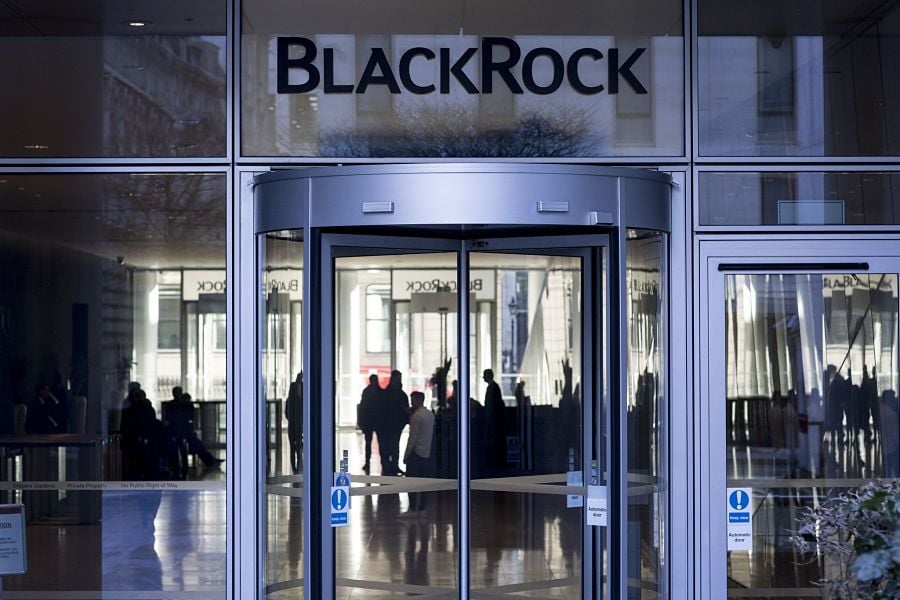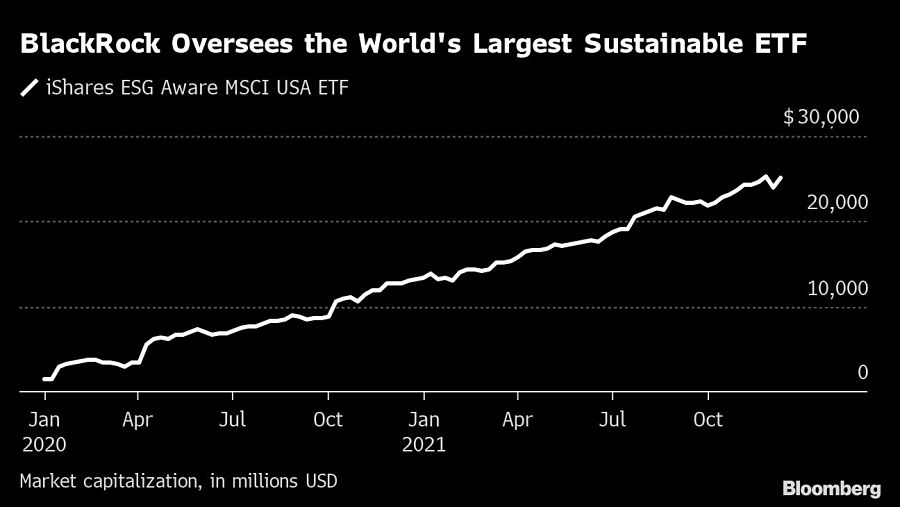

Almost two years have passed since Larry Fink, the CEO of BlackRock Inc., declared that a fundamental reshaping of global capitalism was underway and that his company would help lead it by making it easier to invest in companies with favorable environmental and social practices. Lately, he’s been taking a victory lap.
“Our flows continue to grow and dominate,” Fink said Oct. 13 of so-called ESG, or environmental, social and governance funds, and similar investments. On the same conference call with analysts, he added: “BlackRock is a leader in this, and we are seeing the flows, and I continue to see this big shift in investor portfolios.”
What Fink did not say is that BlackRock drove a significant part of that shift by inserting its primary ESG fund into popular and influential model portfolios offered to investment advisers, who use them with clients across North America. The huge flows from such models mean many investors got into an ESG vehicle without necessarily choosing one as a specific investment strategy, or even knowing that their money has gone into one.
In short, an apparent BlackRock-led rush of investors into ESG in the past two years has been something of a self-fulfilling prophecy, at least when it comes to the biggest such fund on the planet, a BlackRock exchange-traded fund that trades under the ticker symbol ESGU, according to data from BlackRock and Morningstar.
A Bloomberg Businessweek investigation published earlier this month revealed that the ratings BlackRock cites to justify the fund’s sustainable label have almost nothing to do with the environmental and social impact companies in the fund have on the world.
Instead, the ratings primarily are designed to measure the opposite: the potential harm government regulations and other factors might cause to the companies’ bottom line, especially when it relates to addressing climate change. For instance, Bloomberg found that only one of 155 ESG upgrades of S&P 500 companies cited an actual cut in emissions as a factor.
The ratings come from MSCI Inc., which counts BlackRock as its largest customer. (The ESGU fund’s formal name is the iShares ESG Aware MSCI USA ETF). Those ratings, which dominate the world of sustainable investing, have opened the door to ESGU owning companies that have been among those considered the worst offenders by some investors focused on environmental and social responsibility. These include fossil-fuel giants Chevron and Exxon Mobil, along with Facebook (now called Meta Platforms), Amazon, McDonald’s and JP Morgan Chase, which is the biggest financier of fossil-fuel projects since the 2015 Paris Accords. In fact, the ESGU fund holds a heavier weighting in 12 fossil-fuel stocks than the S&P 500 does, according to Bloomberg Intelligence, the research arm of Bloomberg.
Tariq Fancy, BlackRock’s former chief investment officer for sustainable investing, said the Bloomberg Businessweek investigation had helped open eyes in the financial services industry to what’s going on inside ESGU and sustainable funds in general.
“The grading, and the weighting behind it, is dubious,” said Fancy, who left the company in 2019 in part over his frustration with the marketing of sustainable funds. This year he became an outspoken critic of ESG and so-called green investing.
Fancy also noted that ESG funds, including ESGU, generally charge investors higher fees on average than their nonsustainably labeled counterparts. ESGU’s fees are lower than industry averages for sustainable funds but are still five times higher than an S&P 500 tracker that trades under the ticker IVV — a popular BlackRock fund whose makeup and expected performance are closely aligned with those of ESGU.
Even for investors who make a conscious decision to go into ESG, be they institutions or individuals, the funds are doing little other than benefiting Wall Street, according to Fancy.
“There’s no reason to believe it achieves anything beyond sort of giving them more fees, and my concern, obviously, is it would be creating a placebo on top of that,” he said. The placebo in Fancy’s view is making people think they’re helping mitigate climate change or otherwise making the world a better place through investments in ESGU, while emissions continue to climb and social ills grow.
Asked to justify the scale of the fees for ESGU, BlackRock said in a statement that they were 1 basis point, or 0.01%, below the long-term weighted average fee for investors who chose its most popular model portfolio, which includes ESGU in its lineup.
It also said ESGU was included in model portfolios, which are not regulated offerings, as part of its fiduciary obligation to clients; it said ESGU has outperformed the IVV fund by about 2.6% in the past two years, “resulting in significant benefits for our clients, far in excess of the difference in fees between the two ETFs.”
BlackRock markets ESGU as offering investors exposure to companies with favorable environmental and social practices, without saying specifically what that means. But the company said in its statement, “We are clear about the investment strategies and sustainable outcomes our funds are designed to achieve.” It added: “BlackRock believes greenwashing is a risk to investors, which is why we support regulatory initiatives to enhance the transparency” of sustainable funds.

The story of how ESGU became a record-breaking fund and the poster child for the boom in ESG investing began with two letters published on Jan. 14, 2020, by BlackRock and Fink.
In one, Fink warned the CEOs of global companies that they were facing a potential time bomb as investors awoke to the climate crisis. Because his company, which has $10 trillion under management, owns more shares in more big companies than anyone else, CEOs tend to listen. “I believe we are on the edge of a fundamental reshaping of finance,” Fink wrote in bolded text, adding: “In the near future — and sooner than most anticipate — there will be a significant reallocation of capital.”
In a second letter, BlackRock promised the clients behind all that money that ESG would be its lodestar. “We believe that sustainability should be our new standard for investing,” it said. The letters garnered Fink the kind of global headlines that most Wall Street CEOs can only dream of, declaring that he was doing nothing short of remaking capitalism.
One major source of new sales for BlackRock in recent years has been offering model portfolios to financial planners and wealth advisers. In essence, these are free crib sheets. Instead of having to spend time putting together portfolios for clients, the advisers can simply ask them about their financial goals and offer each a selection of prepackaged options; they come courtesy of BlackRock and, not coincidentally, are filled exclusively with BlackRock funds.
Advisers — there are 90,000 certified financial planners in the U.S. — love them. Because BlackRock has done the work for them, the advisers get extra time to pursue new clients, offer additional services or do as they like, all while collecting their fees.
On Jan. 15, 2020, the day after Fink’s letter predicted a major reallocation of capital into sustainability, BlackRock altered its most popular suite of model portfolios by adding ESGU into its “Target Allocation ETF Portfolio Strategies” series. (The biggest and most popular one inside the suite, which offers a 60/40 split between stocks and fixed-income investments, includes ESGU as one of its top two holdings.)
In this way, BlackRock itself helped assure Fink’s prediction would come true. Financial planners who use the models through online platforms have had no choice but to put their clients in ESGU if they wanted to get them into one of the most popular investment strategies for sale.
“We don’t have a say in terms of what goes in there,” said Mohit Desai, a certified financial planner who opened his own advisory firm in Cranford, New Jersey, and uses online models. “That’s entirely on the providers.”
BlackRock said advisers who still use paper models provided by the company, as opposed to online platforms, can make individualized picks.
ESGU had just $1.6 billion when 2020 began, but ended the year up 10-fold, at $16.4 billion. That same year, BlackRock made up about half of the record-breaking fund growth in ESG, and about half of that came from ESGU alone. Wall Street analysts and the media declared ESG had reached the proverbial tipping point and had become a mainstream tool for investors. Wall Street marketing materials and news articles routinely state that investors have been increasing their bets on ESG funds.
What has gotten far less attention is how much models and automated investment platforms have driven the mirage of an investor stampede.
A BlackRock spokesman acknowledged the models have been a significant driver of investment in ESGU. But the precise share is harder to pin down. The spokesman said the company is only able to track flows from its model portfolios that come via online platforms — and about half of the wealth advisers who use its model portfolios use paper.
Still, the spokesman said at least $9.5 billion out of the fund’s roughly $25 billion current total can be traced just to its electronic models, meaning the real total could be much greater.
One rough analogy for what this has meant in financial services: Imagine if the world’s largest grocery company declared it would lead an effort to shift the planet to more sustainable agriculture. And then the next day it quietly slipped some organic carrots into every fruit-and-vegetable box it offered customers across the U.S. Suddenly, organic produce sales would show a huge spike, making it appear as if there was a massive demand shift underway for “sustainable” produce.
Wealth advisers told Bloomberg that investors who got into ESGU may not even recognize that they’re in a sustainable fund, because very few ask about the individual ETFs in the model portfolios they use. ESGU is one of 16 ETFs in BlackRock’s most popular portfolio. And the fact sheet BlackRock gives advisers for the model makes no mention of sustainability as part of the portfolio’s strategy or allocation mix.

Relationships are key to our business but advisors are often slow to engage in specific activities designed to foster them.

Whichever path you go down, act now while you're still in control.

Pro-bitcoin professionals, however, say the cryptocurrency has ushered in change.

“LPL has evolved significantly over the last decade and still wants to scale up,” says one industry executive.

Survey findings from the Nationwide Retirement Institute offers pearls of planning wisdom from 60- to 65-year-olds, as well as insights into concerns.
Streamline your outreach with Aidentified's AI-driven solutions
This season’s market volatility: Positioning for rate relief, income growth and the AI rebound
